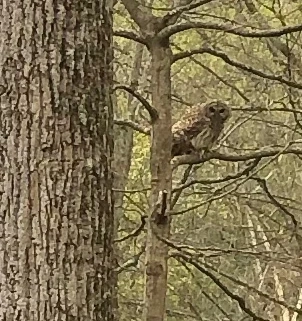Wildlife 2022
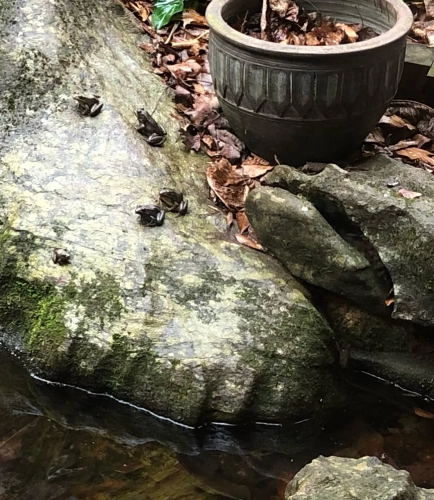 Sights and Sounds
Sights and Sounds
The sounds of Blue Note Garden are decidedly on the quiet side except for when the birds get carried away singing, or the forlorn howling of trains rumbles through across the river, or the wind stirs the two sets of wind chimes and they play a duet. In late winter, owls begin to call and continue for months as they mate and then track owlets—their nest and roost is in full view of the house’s living room windows and a mere 40 feet away.
In summer, the Orchestra of Frogs starts-up—from tiny peepers to bull frogs. The peepers can barely be seen they are so small and in shades of green that match whatever they’ve landed on, but they can certainly crank up the volume at will. In fall, nature is assaulted by humans with industrial-size leaf blowers, determined to remove all leaves, laying waste to what should be valued as bounty.
The Beach House
I hear that a shared family beach house can become a battleground when too many relatives all show up at once.
Well, you haven’t lived until you’ve watched a battle between two squirrels and two barred owls for possession of a bole hole in one particular beech tree. The ongoing struggle is the wildlife highlight of the many grim and gray days of March here at Blue Note Garden.
Now, there are dozens of such holes in our many large trees but, for some reason, this is the piece of real estate that these four creatures want. Every evening as dusk comes on the four engage, with each pair using its strategic strengths in concert to attack and evade maneuvers. The squirrels can jump and run both horizontally and vertically down and up trunks and through a maze of branches. The owls can swoop in, but their wingspan is so wide that twigs can get in their way.
Owlets Away
How good is it that an owlet—perhaps even two or more owlets at a time—can be brought up in a devoted two-parent family, year after year? To paraphrase what author L. M. Montgomery had Anne of Green Gables declare: “I’m so glad I live in a world that has Octobers.” I feel fortunate to live in a world where owlets can grow up with two barred-owl parents working around the clock to respond to their every need for months on end. For years now, I think I’ve sent news alerts out to most of you about the owls who regularly nest winter-through-spring in one of our towering beech trees and I’ve also sent a few photos I’ve been able to furtively take of them. (Ma Owl is, in particular, a force to be reckoned with.)
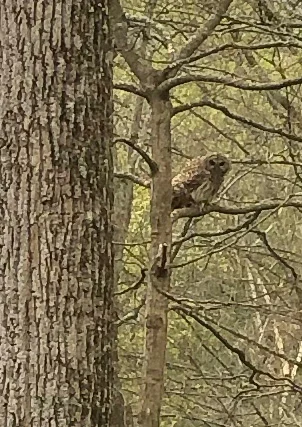 Over this past weekend there seemed to be a lot of chatter from parents to owlets and whining in response from owlets to parents—it would appear that the parents are anxious for schooling in flying and hunting to commence in earnest and 24/7 meal deliveries to begin to decline. Yesterday I finally got to actually see one owlet, rather than just hear him, when he made the momentous climb from deep within the nest cavity to the open threshold of its high entrance. There he mostly preened and fluttered his wings from time to time, taking in the sights. The training wheels really went on this afternoon when he hopped-off and glided from his 30-foot high perch to another small branch in a young but tall maple close by.
Over this past weekend there seemed to be a lot of chatter from parents to owlets and whining in response from owlets to parents—it would appear that the parents are anxious for schooling in flying and hunting to commence in earnest and 24/7 meal deliveries to begin to decline. Yesterday I finally got to actually see one owlet, rather than just hear him, when he made the momentous climb from deep within the nest cavity to the open threshold of its high entrance. There he mostly preened and fluttered his wings from time to time, taking in the sights. The training wheels really went on this afternoon when he hopped-off and glided from his 30-foot high perch to another small branch in a young but tall maple close by.
When I went to do errands in late afternoon, the two parent owls were stationed within 25 feet of the owlet in two different directions except for times when they took turns going over to the exceedingly small branch the owlet had chosen to land on and where the much bigger parents had no choice but to crowd-in to do some grooming—each parent looking badly inconvenienced and awkwardly balanced. I’ve read that the baby owls have heads that are much heavier than the rest of their body, so it is often the case that they will try to rest their head on something, anything, close at hand. (See attached photo of what may be a second, smaller owlet resting its head on the open nest ledge, looking for any sign of its fledging nest-mate.) As soon as a parent departed from the branch, this little one promptly flopped flat-out forward on its front to rest head and body along the full length of the short branch. All tuckered out, indeed!
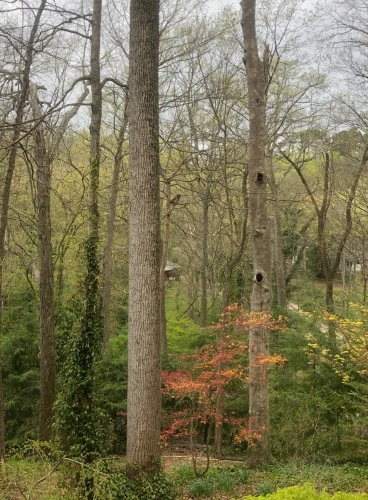
Mind you, this small, if rapidly growing-up, creature has been submerged in a bole where it could not see out for months. It has listened to all kinds of fearsome sounds, including heavy rains and high winds. All of its meals have been dumped into its nest day in and day out. And then it turns out that the very first thing its parents require of it outside the nest is that it should step off the edge of its longtime home and trust that it will be able to arrive somewhere else equally high and nearby. (If I had a ton of money, I’d install a patio area in front of the bole where there could be a place to rest in between fledging flights; on the other hand, the portico platform would make it easier for predators to pay a visit, such as the big red-tailed hawk that had lurked about earlier in the season.) The Driver’s Ed phase of pilot-training seems to have arrived this evening, with the owlet back in its nest and the parents off a little ways hunting.
An old friend in our neighborhood walks long distances every day while she can, beset with early-onset Alzheimer’s; the interminable walking helps to stave-off anxiety over what she knows to be a terminal condition. She walked down the long driveway into Blue Note Garden yesterday to seek my help with a problem she was having with accessing her usual classical music station through her phone and ear buds. But then she told me she didn’t care if it worked because she was just then hearing more birds and other natural sounds than she heard anywhere else—perhaps she should just listen and pay more attention. “Theresa, why is it so alive here?” Her question—that a person with a brain shutting down could still perceive the difference in the sounds of life renewing—brought me near to tears. I asked her to remain very quiet as I took her over to see the parent owls on sentry duty near their young nestlings, all of them bobbing around on a couple of leafy branches way high up in an old growth tree. And then she started to cry, too, as she watched them.
Many of you have probably been urged by me to read This is Happiness (2019) by Niall Williams at one time or another in the last couple of years. Were my husband alive, my copy would have been in a stack by his side of the bed where I put books I thought he’d particularly like. I still pile books there that are most meaningful; the sight of that tower of books has gone from being a source of pain to a cause of succor.
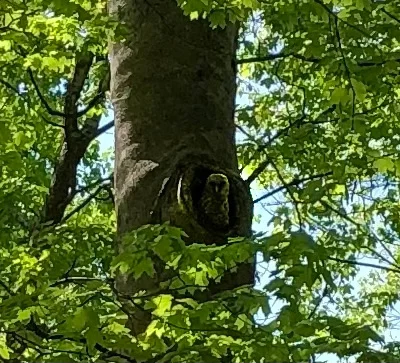 I am often care-worn in my mind about the Earth we are leaving to future generations. As I observe moments in nature here at Blue Note Garden, my fervent hope that a new generation of barred owls will successfully launch into our wild and worrisome world seems a very small concern in the bigger picture of impending catastrophe. This afternoon, as I observed both parent owls closely supervising their offspring and fuzzy owlets playfully taking the plunge into their new lives, I realized that they know what they are doing even if most humans do not. I will miss them but they do not need me to worry about them. My heart fills and I whisper to myself that getting to see them do what they do naturally—“This is happiness!”
I am often care-worn in my mind about the Earth we are leaving to future generations. As I observe moments in nature here at Blue Note Garden, my fervent hope that a new generation of barred owls will successfully launch into our wild and worrisome world seems a very small concern in the bigger picture of impending catastrophe. This afternoon, as I observed both parent owls closely supervising their offspring and fuzzy owlets playfully taking the plunge into their new lives, I realized that they know what they are doing even if most humans do not. I will miss them but they do not need me to worry about them. My heart fills and I whisper to myself that getting to see them do what they do naturally—“This is happiness!”
Very soon, sightings of adults and young will be few and far between with all easily obscured by our forest’s dense summer foliage. I will still hear their calls from time to time and occasionally one will fly down close or roost on a lower branch and stare directly at me. There is also the promise—not the certainty, but the possibility—that they will be back next year. How good will that be!

